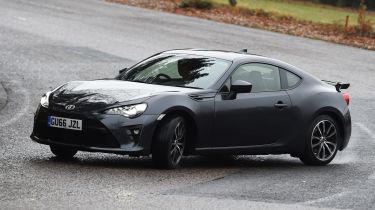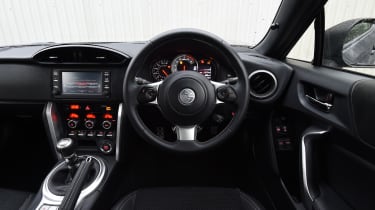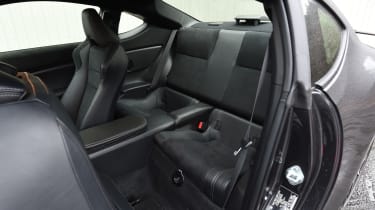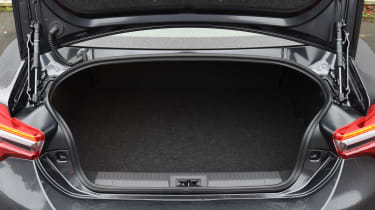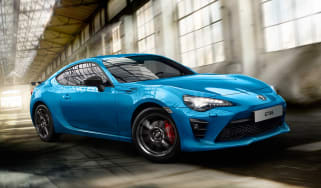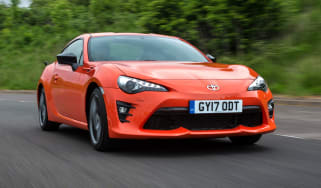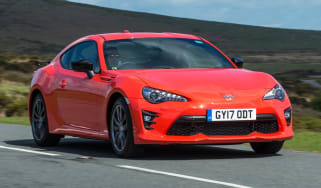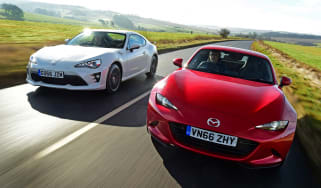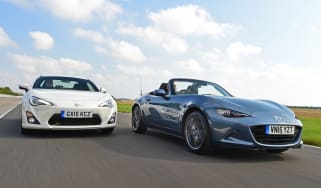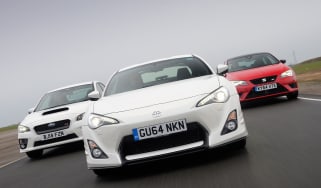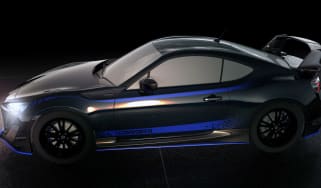Toyota GT86 (2012-2021) review
The Toyota GT86 combines great fun and excellent value in a good-looking package

When the Toyota GT86 arrived in 2012, we praised it for its lightweight body, back-to-basics rear-wheel-drive handling, and characterful Boxer engine. The game has moved on, but in 2017 Toyota applied a light mid-life facelift to keep things fresh. The changes were limited, but a keen eye will spot the wider grille and new bumper design, revised fog lights and new LED headlamps. At the back there's a new set of LED tail lights.
Inside, buyers get more leather and Alcantara trim, as well as handy audio controls on the steering wheel. There's a new 4.2-inch screen embedded in the dials, adding trip functionality and a digital fuel guage.
While the GT86 isn't the most powerful car on sale, the engine begs to be revved and offers plenty of performance for keen drivers. The lightweight body and rear-wheel-drive layout make it one of the best handling sports cars for sale, especially at the affordable end of the segment where the GT86 competes.
Fuel efficiency isn't a GT86 highlight, and neither is the feel of the interior, but if you want one of the most engaging drives in this price bracket, Toyota's coupe delivers.
The Toyota GT86 is one of the most unique cars for sale in the UK today. Aside from the platform-sharing Subaru BRZ, there really isn't anything else like this light, compact four-seater coupe, and the new car market is all the better for its presence.
Used - available now

2022 Mercedes
CLA Shooting Brake
31,342 milesAutomaticPetrol1.3L
Cash £21,495
2020 Volkswagen
Arteon
66,000 milesAutomaticDiesel2.0L
Cash £16,600
2025 Vauxhall
Astra
26,656 milesAutomaticPetrol1.2L
Cash £15,900
2021 Mercedes
A-Class
37,877 milesAutomaticDiesel1.5L
Cash £16,100It shares running gear with the Subaru BRZ, so it specs a 197bhp 2.0-litre flat-four engine which sends drive to the rear wheels via a six-speed manual gearbox (or an optional auto). The GT86's relatively light weight (less than 1.3 tonnes) means that power output is put to good use, while fitting narrow tyres means the car is agile and involving to drive even at lower speeds.
This combination, and a price starting from around £28,000, means the GT86 is one of the cheapest rear-wheel drive sports cars for sale. As well as the BRZ, you could consider the Mazda MX-5 as an open-topped choice, while the Fiat 124 and Abarth 124 Spiders share tech with the Mazda and the same open-top experience. Elsewhere, cheaper versions of the BMW 2 Series Coupe could be considered, while the 2.3-litre Ford Mustang is pricier and heavier.
You could also consider the GT86 as an alternative to the swathe of front-wheel drive hot hatchbacks for sale. That price tag puts in the same ballpark as the Hyundai i30N, MINI Cooper JCW, Peugeot 308 GTi, Renaultsport Megane and VW Golf GTI.
Of course, the GT86's power deficit means it's not as fast as any of these cars in a straight line, but the Toyota's rear-drive layout and 50:50 weight distribution means it's designed to deliver greater enjoyment in the corners. The agile chassis and relatively low grip of the tyres mean you can push the car to the limit of adhesion without travelling too fast, and it's a great car to drive if you want to learn about car control.
There are two versions of the GT86, the standard version and the GT86 Pro. Both are pretty well equipped, with all cars getting 2-zone climate control, cruise control, keyless entry and starting, auto LED headlights and a touchscreen infotainment system. Pro adds leather and Alcantara seats with heating, plus a rear spoiler. Toyota also offers special versions of the GT86, including the Club Series models. These come in exclusive colours including blue and yellow, while a bodykitted TRD version has been offered in the past.
The GT86 follows is a spiritual ancestor to the Corolla AE86 of the 1980s, and that's where the '86' in its name comes from. The 'GT' part is a nod to Toyota's first sports car, the 2000GT. Toyota produced a number of FT86 concepts before the final production car arrived in 2012. It went on to win our Performance Car Of The Year test in that year, and as well as the Subaru version, the US market saw the car sold as the Scion FR-S, before that Toyota sub-brand was wound up in 2016.
How much does the Toyota GT86 cost?
Prices range from around £28,000 to £32,000, but you can get all the fun of driving the GT86 from the standard car, which makes the other versions, especially the automatic model, seem excess to requirements.
Engines, performance and drive
With its low price and impressive handling, the Toyota GT86 has few rivals that come close to beating it for driving enjoyment at such a low cost. However, with the newer Mazda MX-5 now on sale, the Japanese coupe doesn't have it as easy as it once did.
The rear-wheel-drive chassis on the Toyota GT86 is perfectly balanced, however. There's loads of feedback from the steering and the brakes are strong without biting harshly, meaning the driver gets loads of confidence when driving quickly.
An even weight distribution means the car still feels well balanced, while responsive steering allows you to catch tail slides with relative ease. On track, you can easily turn a slide into a drift by keeping the power on, although circuit use also demonstrates that the GT86 could easily cope with an extra 50bhp, which would make it all the more entertaining.
In fact, owners often complain that the GT86 isn't really fast enough, yet in slippery conditions, 197bhp feels like plenty. Despite a mild facelift in 2017, however, there's still no option for a more powerful turbocharged version. The aforementioned facelift did make some changes to the shocks and steering, but you'd be hard-pushed to notice the changes without driving the two cars back-to-back.
The interior can get a bit noisy at speed and the firm suspension is a bit bouncy on the motorway – but the GT86 will put a smile back on your face as soon as you turn onto a twisty A-road.
Engines
The 2.0-litre flat-four boxer engine generates 197bhp and 205Nn of torque. Those are relatively modest numbers for a car of this nature, and to keep the power flowing, the Toyota's gearbox needs to be worked quite hard. Keen drivers won't mind too much, and the car will manage 0-62mph in 7.6 seconds with some nimble shifting.
Opt for the auto and you get a traditional torque converter unit rather than a dual-clutch set-up, although Toyota reckons its gearbox has software that mimics the feel of a dual-clutch box. It saps power though, to the extent that 0-62mph takes a rather pedestrian 8.2 seconds.
The ageing Nissan 370Z offers much more torque than the GT86, and some may prefer its muscular 324bhp V6 engine to the free-revving unit in the Toyota. All versions of Audi’s TT are quicker than the Toyota, too.
However, if you’re prepared to push for performance and are more interested in the actual drive than comparing vital statistics, then the GT86 can prove extremely rewarding.
MPG, CO2 and running costs
Despite its small 2.0-litre engine, the Toyota GT86 is surprisingly expensive to run. The six-speed manual version returns up to 33.2mpg on the WLTP test cycle and emits 196g/km of CO2. The truth is, of course, that driving the GT86 in the manner intended is likely to see consumption quickly drop to the wrong side of 30mpg.
To put the figures into perspective, a similarly specced Audi TT with 2.0 TFSI power returns around 46mpg. The Audi is also far cleaner thanks to CO2 emissions of 138g/km.
The Toyota GT86 with the automatic gearbox has slightly better figures. It manages a slightly improved 32.8mpg, but emissions of 183g/km are a lot better. However that model is best avoided as the manual is faster and far more fun. If you're looking at buying a GT86, you'll probably be happy to sacrifice some economy and emissions for the added fun of the manual box.
Unlike rivals from BMW and Audi, Toyota offers no fuel-efficient alternative to the petrol engine - a diesel would add weight, as would Toyota's hybrid system.
Servicing and maintenance costs should be reasonable for the Toyota GT86 though, and all models come with Toyota's five-year warranty so it’s not all bad news.
Insurance groups
The Toyota GT86 sits in two insurance groups: 34 for the manual and 35 for the auto.
Depreciation
The GT86 appears to be gaining cult status as one of the last naturally aspirated, manual sports cars for sale. While residuals in the past haven't been that impressive, a retained value of 47-48 per cent after 3 years/60,000 miles for the current car are actually better than the returns for the 2.0 TFSI Audi TT. However, the Mazda MX-5 has stronger scores, although the folding hard top-equipped RF is at a similar level to the Toyota.
To get an accurate valuation on a specific model check out our free car valuation tool...
Interior, design and technology
The Toyota GT86 is a traditional-looking sports car with aggressive styling, which includes a long bonnet and a short tail, plus a large front grille and rear splitter with twin exhausts. The Subaru BRZ is virtually indistinguishable, aside from the badges.
The Audi TT has a more premium feel and appearance, especially on the inside, but the way the Toyota GT86 looks reflects its personality - it's fun.
The interior of the Toyota GT86 is full of cheap-looking plastics, but the layout (flick switches, for example) and the mock-carbon fibre trim on Pro models make it feel like a road-going racer. A 2017 facelift added more leather and Alcantara trim for the Pro model, too, as well as a digital trip computer screen amongst the dials, but hot hatch rivals such as the Peugeot 308 GTi are cheaper to buy and nicer inside.
The Toyota GT86 TRD came with an even more aggressive body kit, which has a different front spoiler, side skirts and special 18-inch alloy wheels. This TRD bodykit isn't available via the UK dealer network, so if you want it, you'll need to search for it on the Japanese market.
Another special edition was the GT86 Aero, which had a bit of extra visual impact. There's a new bodykit, deeper front bumper and side skirts and a carbonfibre-effect rear diffuser. The most noticeable addition is a huge rear wing which looks a little bit like an awkward aftermarket add-on. Lighter forged alloy wheels were also part of the upgrade, which were designed to help reduce unsprung weight.
Sat-nav, stereo and infotainment
All GT86 models come with a six-speaker audio system, which is part of the Toyota Touch multimedia package. Featuring a 6.1-inch touch screen, the Bluetooth compatible system acts as the single interface for everything from sat-nav to smartphones.
There are a limited number of apps, including a ‘send to car’ function for google location searches. Upgrading to Touch & Go Plus adds voice recognition and email integration.
Practicality, comfort and boot space
The GT86 is a 2 plus 2, which means it comes with a back seat divided into a pair of buckets with safety belts for two passengers. It may as well not have any though, as it’s so cramped back there as to be virtually unusable by anyone out of junior school.
But that’s not really the point of the GT86, and for those up front there’s plenty of space to enjoy. For the driver there’s plenty of seat and wheel adjustment, although the low-slung driving position could hamper the view out if you’re short in stature – which would be particularly noticeable if you came to the Toyota from a sporty hatchback.
The big rear wing on the Aero model means rear visibility was compromised on that version, especially over the shoulder. Rear parking sensors are only available as an option for around £250.
There’s a surprising amount of cabin storage if you're travelling two-up, though, with big door bins and a decent glovebox, as well as space for your phone and drinks in the centre console.
Dimensions and size
As you’d expect from a proper sports car, the GT86 sits quite close to the ground. At just 1,285mm tall it’s nearly 7cms lower than an Audi TT. The Toyota is 4,240mm long, so 6cms longer than the Audi.
Leg room, head room & passenger space
Legroom in the back seats is limited for even the smallest occupants, so the rear is only really useful as extra storage space. Even trying to accommodate a single person sitting sideways across the rear seat is made trickier by the central console that extends right through the car to the rear seat back.
You do get Isofix mounts for child seats, though, although getting the kids strapped into them might feel like a bit of a chore if you have to do it more than occasionally.
Boot space
You don’t buy a GT86 for practical reasons, but it does come with a 237-litre boot, which is easily big enough to take the weekly shop or use on a weekend away. The back seats fold in a 50:50 split, and the car’s designers claim the space is big enough for you to carry a full set of wheels and tyres – the idea being you can take a set of sticky rubber with you if you head out for a track day.
Reliability and safety
Toyota has a reputation for producing bulletproof cars, although the GT86 is actually built by Subaru. However, there’s plenty of similar technology used by both manufacturers, and a GT86 should be stress-free to own. It’s helped by the fact you get a very good warranty, while Toyota dealers have a good reputation for customer service, too.
As brands, both Toyota and Subaru score very well in the overall Driver Power manufacturer survey ranked in the top half of the manufacturer list, usually high in the top 10. That places both ahead of VW, Honda and Audi.
However, the GT86 wasn’t one of Toyota’s star performers, attaining only an average 95th place for reliability out of the 150 cars surveyed in 2016, one of the few times it has appeared in the list of vehicles. Owners slated it for build quality (139th-place) and practicality (141st), although road holding (8th) and seat comfort (19th) were much better.
On the safety front, the GT86 features seven airbags, while the electronic stability control has a Sport setting designed to allow you to maximise track fun without disabling all of the safety systems. A limited-slip differential (for better grip in corners) comes as standard too. The car hasn't been tested by Euro NCAP, and probably won't be due to its low sales volumes. But every modern Toyota has done well in the tests, so there's no doubt that the GT86 would perform just as well.
Warranty
A good reputation for reliability isn’t just a great marketing boost; it also means Toyota can afford to offer one of the best manufacturer warranties in the business. That means full factory cover for five years, up to a limit of 100,000 miles. Other coupe rivals such as the Audi TT and BMW 2 Series Coupe come with only three years of cover.
Servicing
Servicing should be pretty reasonable at Toyota workshop rates, and the company offers fixed price deals for intermediate and full services on the GT 86 at around £180 and £300 respectively. You can also spread the cost monthly if you're buying on finance.
